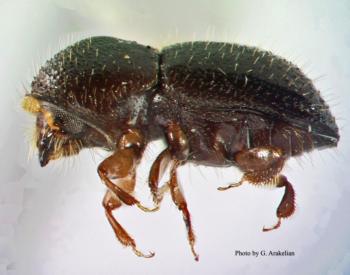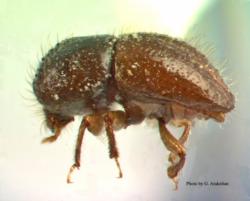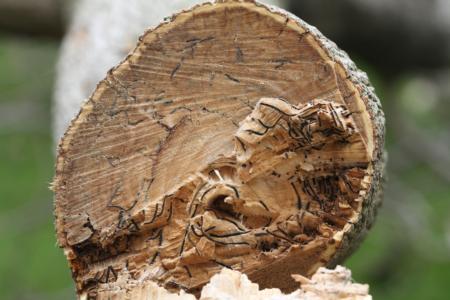The Polyphagous Shot Hole Borer: A New Tree Pest in Southern California
by John Kabashima and Monica Dimson
Southern California’s urban forest and nursery industry are threatened by an infestation of an invasive beetle pest. In 2012, DNA analysis of beetles from an avocado tree in Los Angeles County determined that the insect was a new species. This beetle was named polyphagous shot hole borer (PSHB), although it still has to be described scientifically and given a species name (for now it is Euwallacea sp.). Since then, PSHB has been observed on a wide variety of trees common to urban landscapes and natural areas of Los Angeles, Orange, Riverside, and San Diego counties. What makes PSHB so dangerous is that it is the vector for a Fusarium fungus that causes a disease called Fusarium dieback, which is potentially fatal to susceptible host species (Editor’s note: See “Disease Focus” and Steve Tjosvold’s “Observations” in this issue for more information about this disease).
This small beetle has attacked hundreds of different tree species (hence the name “polyphagous”), and so far, scientists have been unable to identify its method of host selection. The beetle’s long host list includes over 110 tree species that are susceptible to Fusarium dieback. New reproductive hosts—tree species in which PSHB can cultivate the fungus and successfully produce offspring—continue to be discovered. For now, the list of 27 reproductive hosts includes avocado, box elder, castor bean, English oak, coast live oak, cork oak, Engelmann oak, valley oak, California sycamore, coral tree, red willow, weeping willow, sweet gum, Palo verde trees and several species of maple.
Early infestations are very difficult to detect. The beetle itself is tiny: females are black in color and about 0.07 to 0.1 inch long (fig. 1), while the brown-colored males are smaller, at 0.05 inch long (fig. 2). Entry and exit holes of this beetle are a mere 0.033 inch in diameter. Luckily, some host trees respond with obvious gumming (e.g., goldenrain tree), bleeding (e.g., California sycamore), or white-sugar exudate (e.g., avocado) at the entry hole, but staining can be subtle, tricky to recognize, and differs greatly from host to host.



PSHB is a new pest in Southern California, and many questions about its management and the regulatory impact on nursery shipments still need answers. However, collaboration between UCR (Dr. Tim Paine, Dr. Eskalen and Dr. Richard Stouthamer), UC Cooperative Extension, Orange County (John Kabashima), Orange County Parks, and West Coast Arborists has allowed us to share what resources and information we do have. We encourage all growers and land managers to alert us regarding any potential sightings of PSHB and to be vigilant, as always, about the movement of firewood.
For more information about this pest, check out the website information listed in the resources below.
Resources:
Arakelian G. 2012. Polyphagous shot hole borer (Euwallacea sp.) vectoring Fusarium dieback (Fusarium sp.). County of Los Angeles, Dept. of Agricultural Commissioner/ Weights and Measures. http://acwm.lacounty.gov/pdf/Polyshotholeborer.pdf.
Eskalen A, Stouthamer R. 2012. New beetle, fungus disease complex threatens avocado production. From The Grove 2(2): 3. http://www.californiaavocadogrowers.com/sites/default/files/2012-Summer-From-the-Grove.pdf.
Eskalen A. 2014. Fusarium Dieback / Polyphagous Shot Hole Borer. http://eskalenlab.ucr.edu/avocado.html.
Eskalen A. 2014. Polyphagous Shot Hole Borer (Euwallacea sp.) and Fusarium Dieback (Fusarium sp.). Center for Invasive Species Research, University of California, Riverside. http://cisr.ucr.edu/polyphagous_shot_hole_borer.html.
Stouthamer R, Rugman-Jones P, Eskalen A, Gonzalez A., Arakelian G, Hodel D, Drill S. 2014.Polyphagous Shot Hole Borer. http://ucanr.edu/sites/socaloakpests/Polyphagous_Shot_Hole_Borer/.
Western Plant Diagnostic Network. 2012. Polyphagous shot hole borer vectors Fusarium disease in California. WPDN First Detector News 5(2):6-7. http://www.wpdn.org/webfm_send/254.
John Kabashima is Environmental Horticulture Advisor and Monica Dimson is Staff Research Associate, UC Cooperative Extension Orange County.












